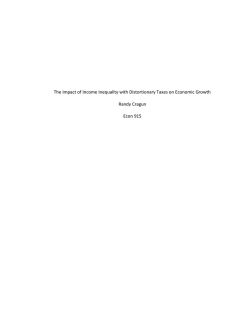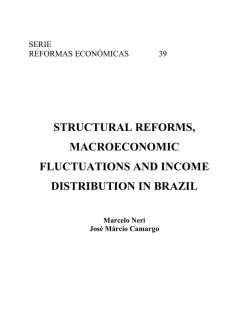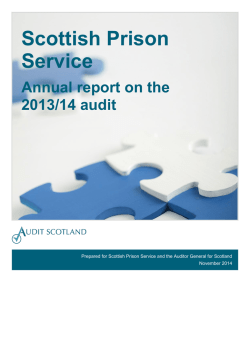
Public Services Futures 11 - Winter 2015
Winter 2015 Issue: 11 For people who care about public services Cuts and More Cuts A budget package in December may not be Autumn, but it certainly had a real chill for those least able to afford its consequences. This was a classic Osborne budget statement. Massive real cuts, sugar coated with a few pennies in the form of announcements on the NHS and infrastructure. Scotland will get £129m of Barnett consequentials from the NHS announcements, but this goes nowhere near making up for the real cuts ahead. Public spending in the UK will be the lowest for 80 years. The Office for Budget Responsibility, said: "Between 2009-10 and 2019-20, spending on public services, administration and grants by central government is projected to fall from 21.2 per cent to 12.6 per cent of GDP and from £5,650 to £3,880 per head in 2014-15 prices. Around 40 per cent of these cuts would have been delivered during this Parliament, with around 60 per cent to come during the next. The implied squeeze on local authority spending is similarly severe." This is entirely a consequence of the failure of austerity economics. The OBR also tell us that real earnings will not return to precrisis levels over the next five years after a continuous fall since the crash. Pay freezes, low paid new jobs, low incomes of the involuntary self-employed are behind the apparently improving unemployment figures. This is the reason why tax revenues have not grown sufficiently, and public borrowing has increased despite draconian public spending cuts. Osborne told us proudly that he has halved the deficit. But in 2010 he told us that it would have gone by next year. Instead he has borrowed more than Labour. We need a massive programme of public investment in social care, public transport, Three things to do today: Read about the problems in London’s shared services Learn about how being a union member makes you happy Ask a friend to join Fatter Cats B housing, child care and education, which will tackle the investment and decent work deficit. Then we need labour market policies to ensure that the fall in labour’s share of national income in the past decades is reversed, and the recovery is wage-led rather than debt-led. Household debt will grow faster than previously forecast until it’s larger than before the recession. In simple terms, take care of full employment, decent pay for women and men, equality, and sustainability, and the budget will take care of itself. If you were in any doubt about the political strategy behind the Autumn Statement its keep the rich on board. The top 10% will vote Tory come what may to protect their tax cuts that are threatened by Labour. The big losers are again at the bottom, the 'dog end voters in the outlying regions' as one Tory MP put it. Osborne’s economic policies have been deliberately designed to shift money from the poorest to the richest. Research from the London School of Economics has found that the changes he has introduced to benefits and income tax have seen the poorest five per cent lose income while the top one per cent have gained. Austerity is the Tories cover for their real political goal of reducing the size and role of the state. ritain’s top bosses had already made more money in 2015 than the average UK worker will earn in an entire year by January 6th this year. The High Pay Centre's calculations show that earnings for company executives returning to work on Monday January 5th passed the UK average salary of £27,200 by late afternoon on ‘Fatcat Tuesday’: Less than two days work! FTSE 100 Chief Executives are paid an average £4.72 million, the equivalent to hourly pay of nearly £1,200. When the High Pay Centre made the same calculation last year, they estimated that top bosses had to wait until the first working Wednesday of 2014 to surpass the earnings of the average worker. While the pay of FTSE 100 Chief Executives has risen by nearly £500,000 since last year, the annual pay of the average UK worker has increased by just £200, from £27,000 to £27,200. TUC General Secretary Frances O’Grady said: "It’s a stark reminder that while the average worker is £50 a week worse off than in 2010, boardroom pay gets bigger and bigger every year. We urgently need a change of course to put wage growth for all workers at the heart of Britain’s economic plan – if not then people’s living standards will not recover and the economy will remain in the dan- www.unison-scotland.org.uk NEWSLETTER Critical Friends T he review of shared services in Hammersmith, Fulham and Westminster Kingston and Chelsea shows that sharing is not as easy as its advocates would have us believe. When Labour took control of Hammersmith and Fulham Borough (LBHF) one of their manifesto commitments was a review of shared services arrangements with the Westminster (WCC) and Kingston and Chelsea (RBKC) authorities. This “critical friend” review has now been published. The report makes key recommendations for improvement around: Vision Leadership accountability structures Governance procurement Technology. What’s interesting from a UNISON perspective is that it contains a survey of staff across the 3 boroughs. The survey was sent to all staff in LBHF and all staff working in shared services in the other two boroughs (RBKC and WCC). There was a great deal of agreement among staff the key challenges were solving the different processes technologies and cultures which make shared working difficult and a huge feeling of uncertainty about what the future held. “cost savings were the over-arching priority ” Uncertainty: most respondents picked “neither agree nor disagree” when asked whether shared services had enabled cost savings and service improvements. It was generally felt that costs savings were the overarching priority for sharing services. LBHF staff felt more strongly than the other boroughs that shared services “does not improve individual borough’s ability to serve own residents”. Personal development: while staff felt that sharing best practice and working shared teams offered personal development opportunities there were serious levels of concern about job security. This may though be a general, and not unrealistic, concern felt by all workers across local government considering the level of budget cuts they face. "enduring variance in terms and conditions ”. Staff are pretty evenly split between those who would like to see more joint working and those who want to see it end, and 16% who didn’t know. Finance and corporate services were most keen to return to single borough operations. Another issue is the “enduring variance in terms and conditions between and within teams”. This creates “difficult working environment”. The report states that there is a risk that “the good will of staff is being stretched too far”. The technological issues are significant, there are three IT systems leaving an admin heavy workload this often leads to the recruitment of temporary staff to process transactional backlogs: Hardly the best way to spend money. As with other shared services projects there are real issues about individual borough accountability and the ability of boroughs to design and deliver on their individual visions for the future of their areas. The report is of course full of typical business jargon, but if you go past that it highlights the challenges members will face as more of these plans are evolving in Scottish Authorities. It is important that when meeting with mangers and elected members that we can highlight what has happened elsewhere to avoid costly mistakes being repeated here. FOI Threat I mmediate steps must be taken to protect freedom of information (FOI) rights from the damage caused by the outsourcing of important public services. That's the message in a special report from The Scottish Information Commissioner, Rosemary Agnew to the Scottish Parliament. The Report explains that the provision to extend FOI to non-public sector organisations delivering public functions has been “woefully underused” in the ten years since FOI law came into effect, with the consequence that some public functions are no longer open to full public scrutiny. The Commissioner’s report reflects growing concern about the impact of changes in public sector delivery on information rights, something that UNISON Scotland has highlighted many times. Since 2005, over 15,000 Scottish households have lost FOI rights following the transfer of local authority housing stock to housing associations and many more as services, particularly in the care sector, have been outsourced. While the Scottish Government has the power to extend FOI to third parties that provide public services, this power has only been used once in the last decade. This was in 2013 for the designation of local authority leisure and culture trusts. The Commissioner’s Special Report contains a number of recommendations for action by Scottish Government Ministers to address her concerns. The recommendations include: • adopting a policy to ensure FOI rights are migrated whenever a body delivering public functions or services changes • carrying out a review to identify where FOI rights have been lost over the past decade, and reinstate them • taking steps to ensure that FOI rights apply to those bodies responsible for social housing and private prisons and • adopting a factor based approach to wider FOI designation, to ensure that FOI rights apply to bodies which are considered to be delivering functions of a public nature. W e generally highlight the more material benefits of joining a union but a US study has found that being a union member actually makes you happy. The study of happiness or life satisfaction is becoming increasingly popular: even the Tories are measuring it. Studies measure both how people say they feel, things they do like laugh and smile and some include asking participants' friends and family to rate the subjects happiness as well as professional and clinical assessments. UNISON has joined others like Oxfam in campaigning for wider of use of these types of measures rather than for example GDP as a measure of a country’s success. Two American academics have used data from a range of life satisfaction studies to see whether membership of a trade union “contributes to a higher quality of life”. They found that union members are more satisfied with their lives than non members and that the effect of union membership “rivals other common predictors of quality of life”. The researchers give four suggestions as to why : Unions give members a route to influencing how their workplace operates, they have routes to appeal management decisions and processes to deal with problems. Union members are better paid and have more secure employment especially in the US. Unemployment and worry about unemployment are major predictors of poor mental and physical health. Union membership reduces this type of stress and anxiety. Unions provide lots of opportunities to for social interaction. Unions promote active citizenship, there is a growing body of evidence that being active in a community and achieving things through this activity improves how we feel about ourselves and the communities in which we live. As well as gaining better wages and holidays joining a union will make you happier. Who could say no to that? Inequality in Scotland I nequality in Scotland: New Perspectives from David Bell, David Eiser and Michael McGoldrick, adds some much needed detail and policy analysis to an often simplistic debate around poverty and inequality in Scotland (and elsewhere). The paper contains a great deal of data from large scale surveys over the last thirty years attempting to identify the economic and social trends in Scotland. There is also an analysis of the effect of policies on the distribution of income between rich and poor both those where that is the intended aim (tax and welfare) and others (housing or energy policy) which have other objectives. Their analysis finds that the extent of distribution hasn’t changed much since the 1980s. The UK tax and benefits system still redistributes income at about the OECD average. As expected the minimum wage has been effective in raising wages at the bottom. This makes life better for lots of people. Sadly, if high earners continue to see massive increases in their wages and don’t pay a reasonable amount of tax on those earnings, income inequality will (and does) remain high. There is a detailed section on the Living Wage. Their research indicates that low pay is widespread across Scottish households with many combining a mix of high, medium and low earners. While the living wage will address individual wage inequality, household income inequality may not reduce. The picture is therefore complex. Within households the presence of a medium (or high earner) does not mean all those in the household have access to that income. Inequality exists within as well as between households. This analysis is therefore important but not really an argument against expanding the living wage to more workers. There is a lot of debate about income tax and welfare spending in Scotland, much less discussed recently is the role of indirect taxes, which across the world are increasingly favoured by governments as an alternative to direct taxation. These increase inequalities as poorer households contribute more of their income on, for example VAT, than the rich. The same is true of energy “The tax debate isn’t just about levels but about how we use the money that’s raised” policy as although better of people have higher bills the costs of energy takes up a much larger proportion of poorer households’ incomes. What the report doesn’t look at all is the impact of public services on inequality and their role in reducing inequality through redistributing the cash value of services that would have to be paid for directly if not provided free at the point of use, like sending children to school, getting your refuse collected or visiting the doctor. This would have been a useful addition to the research. The tax debate isn’t just about levels but about how we use the money that’s raised. NEWSLETTER Happy Days NEWSLETTER Metropoles: France’s City Regions A cross Europe the twin challenges of ageing populations and the recession caused by the financial crisis mean public sector reform is high on the political agenda. France has moved quickly to make substantial changes to local government. They are reducing the number of regions from 22 to 13 and on January 1st 10 new city Regions were set up. Two more will follow a year later. It is claimed that this is the "first major reorganisation since Napoleon". While the previous government also looked at reform the present government has moved quickly to implement change. The French President, Francois Hollande, claims this will save €12.2B. Local communes do continue to exist, the new city regions (Metropoles) provide a way for them to work together to provide services for the entire Metropole area. Over the next few years further powers will be devolved to these authorities. These include economic development, housing, water and skills. The three biggest cities will also gain powers over tourism, culture, agriculture and international relations. The two “super metroples” which come into place next year are Grand Paris and AixMarseille-Provence. Grand Paris will include at least three of the current suburban departments and possibly more. It is hoped this will increase investment in these suburban areas. The plans weren't universally welcomed when first announced, for example those in relatively rich Alsace didn't appear keen to merge with Lorraine, where the decline of steel and mining industries has had a severe impact on the economy. The plans for new regions were though passed in December so the merger will go ahead. Interestingly while many in Scotland highlight the strengths of the localism of countries like France the French are actually are becoming more centralised. Still a long way from our increasingly centralised system though. Keeping It Local Works L ocal authorities are more effective in supporting people into work centrally driven programmes. Research by the National Institute for Economic and Social Research shows that local programmes using a wide range of interventions like advice and guidance, training, coaching and mentoring, work placements and apprenticeship have been very effective particularly in areas with high levels of deprivation. These are areas where national programmes have struggled. was no threat of loss of benefits participants were all volunteers. Five main lessons from these projects any new service must link with existing provision councils have a particular role in helping those who are not claiming out of work benefits and are therefore usually not getting any support services need to address barriers to work like health and housing people who have been unemployed for a long Rather than competition services were brought period of time need services to be accessible, together enabling a one stop shop approach. Peoattractive, useful, flexible and provide one-one ple tend to lead complex lives with multiple chalsupport lenges so being able to connect a wide range of services makes a big difference. Local authorities services need to be linked to the needs of local are also able to use their links with employers deemployers to ensure that training matches jobs veloped through their long term role in economic that are available in the local area development. The research provides more backing for those, Individual support was also crucial: staff like UNISON, who want to see Job Centre Plus caseloads were small enough to ensure that cliprogrammes and the funding devolved to local ents could have intensive support and as there authorities If you would like more information on any of the articles in this newsletter or have information you would like to share in the next issue please contact: Kay Sillars in the Bargaining and Campaigns team on 0141 342 2819 [email protected] Follow us on Produced by UNISON Scotland’s Bargaining and Campaigns Team, UNISON House, 14 West Campbell Street, Glasgow, G2 6RX.
© Copyright 2025

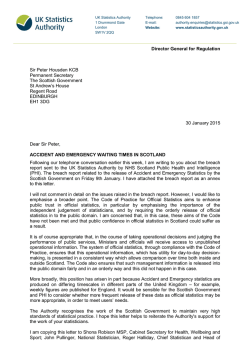






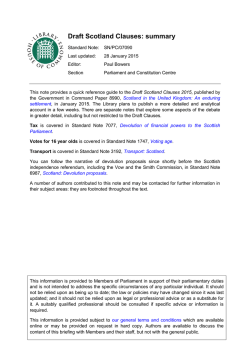
![Flyer on the event [PDF]](http://s2.esdocs.com/store/data/000461133_1-4d88ad04a2122eb11dffd05a58c0a0a8-250x500.png)

